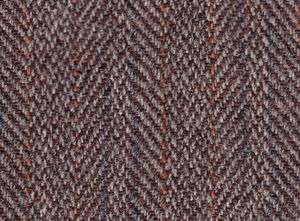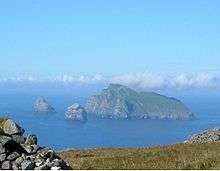Boreray sheep
|
A Boreray ram. | |
| Conservation status | Critical |
|---|---|
| Country of origin | Scotland |
| Distribution | Scotland |
| Use | Conservation Grazing, Meat, Wool |
| Traits | |
| Weight | Male: 45kg |
| Female: 30kg | |
| Height | Male: 55cm |
| Female: 55cm | |
| Horn status | Horned |
|
Sheep Ovis aries | |

The Boreray is a breed of sheep originating on the St Kilda archipelago off the west coast of Scotland and surviving as a feral animal on one of the islands, Boreray.
The breed, also known as the Boreray Blackface or Hebridean Blackface,[1] was once reared for meat and wool, but is now used mainly for conservation grazing. The Boreray is one of the Northern European short-tailed sheep group of breeds.
It is the rarest breed of sheep in the United Kingdom. It is the only breed classed as "Category 2: Endangered" by the Rare Breeds Survival Trust, because fewer than 300-500 are known to exist.
St Kilda sheep
Several types of sheep have been associated with St Kilda. In addition to the Boreray, these include the Soay sheep, a feral type from Soay (one of the other islands in the St Kilda archipelago), and the Hebridean sheep, which was formerly called the "St Kilda sheep", although the sheep it was derived from were probably not in fact from St Kilda itself.[2][3]
History
Until the late eighteenth century, the domesticated sheep throughout the Scottish Highlands and Islands belonged to a type called the Scottish Dunface or Old Scottish Shortwool, which was probably similar to the sheep kept in the whole of northern and western Europe up to the Iron Age. A local variety of Dunface was kept on the two main St Kilda islands of Boreray and Hirta by the crofters of the islands, who lived on Hirta, the largest island of the archipelago.[4] Modern breeds descended from the Dunface include the Boreray and also the North Ronaldsay and the Shetland.[5]
In the mid-eighteenth century the crofters' sheep were described as being "of the smallest kind", with short, coarse wool, and all having horns – usually one pair, but often two pairs. At that time there were about a thousand of these sheep on Hirta and about four hundred on Boreray.[6]
In the late nineteenth century the crofters' sheep were cross-bred with Scottish Blackface sheep,[7] which by then had replaced the Dunface throughout mainland Scotland.[8]
Before the evacuation of the St Kildian inhabitants, these sheep were farmed.[9] However, when the St Kilda archipelago's human inhabitants were evacuated in 1930, the sheep of Hirta were also removed and in 1932 they were replaced by Soays, which still live there as well as on Soay itself. Meanwhile, the remaining sheep on Boreray were left to become feral;[7] these became the only survivors of the crofters' sheep, and one of the few surviving descendants of the Dunface. This means that they are the original, unmodified sheep that used to be farmed on the island.[10] In the 1970s half a dozen of them were exported to form the basis of a breeding population on the mainland, but the majority of Borerays still remain on the island.[11]
Characteristics

Despite being partially derived from a long-tailed breed (the Scottish Blackface), Borerays display characteristics which group them with other northern European short-tailed sheep. They are amongst the smallest sheep, with mature ewes weighing 28 kg (62 lb) and standing 55 cm (22 in) at the withers.[10]
They have naturally short tails, which do not require docking. They also moult their fleece naturally, rather than having to be shorn annually, though older individuals do not moult as easily and may require additional shearing.[4] Fleeces are grey or creamy white on the body, though darker individuals occur whose colouring is similar to the Soay sheep. Rough in quality, the wool is mostly used in the creation of tweeds or carpet yarns. A tweed is a rough-surfaced coarse cloth, typically made in Scotland. Its colour is a mix of flecked colours.[12] The face and legs are wool-free and black and white, with the proportions varying between individuals.[13]
Both sexes of the Boreray display horns, formerly sometimes more than one pair, but in the modern breed always only one pair. The horns on the ewes tend to be thinner than those on the males and while they curve they do not spiral beyond 360 degrees. Mature rams can grow especially large, spiral horns which may be used for crafts such as making shepherd's crooks.[1][11] The horns on the rams have been described as "striking and majestic" by one farmer of the breed.[14]
Population
In 1999 the population was estimated to be at less than 84, with 74 ewes. In 2002, there were between 92 and 100 animals, with 92 ewes and the male population estimated to be less than 7. In 2012, 204 ewes were registered in herdbooks.[15] According to the Rare Breeds Survival Trust, there are fewer than 300-500 sheep in the UK, so they are classed as "Category 2: Endangered". They are the only breed in this category, and therefore the rarest breed of sheep in the United Kingdom.[16]
Use in farming
The breed was primarily reared for meat and wool, but due to its rarity it is now reared for conservation purposes, if reared at all, as most of the population is thought to be feral.[17][18]
Due to the native conditions of where it developed, the Boreray is very well suited to conservation grazing, which is grazing that uses livestock to improve biodiversity and achieve nature conservation in a given area.[19] However, the Rare Breeds Survival Trust believe that this could be further capitalised on if the breed is developed further.[11]
See also
References
- 1 2 "Boreray". Breeds of Livestock. Oklahoma State University Dept. of Animal Science. Archived from the original on 22 November 2015. Retrieved 2008-07-10.
- ↑ "Hebridean Sheep History". The Hebridean Sheep Society. 2011. Archived from the original on 20 November 2015. Retrieved 21 November 2015.
- ↑ "Boreray sheep". Soay Sheep Society. Retrieved 21 November 2015.
- 1 2 "Essex Rare Breeds — Boreray Sheep". Millfields Rare Breeds. Archived from the original on 22 November 2015. Retrieved 7 November 2015.
- ↑ Trow-Smith, Robert (3 November 2005). A History of British Livestock Husbandry, 1700-1900. Taylor & Francis. ISBN 978-0-415-38112-3.
- ↑ Macaulay, Kenneth (1764). The History of St Kilda. T Becket and P A De Hondt. p. 129.
- 1 2 "Land Mammals". National Trust for Scotland. 2003. Retrieved 22 November 2015.
- ↑ "Scottish Dunface history". Hebridean Sheep Society. 2 March 2011. Archived from the original on 22 November 2015. Retrieved 7 November 2015.
- ↑ Long, John L. (2003). Introduced Mammals of the World: Their History, Distribution and Influence. Csiro Publishing. p. 527.
- 1 2 "Sheep Breeds". Smallholder Series. Retrieved 21 November 2015.
- 1 2 3 "RBST Breed profile". Rare Breeds Survival Trust. Archived from the original on 22 November 2015. Retrieved 6 November 2015.
- ↑ "Tweed". Oxford English Dictionary. Retrieved 21 November 2015.
- ↑ "Wool of the Boreray Sheep". British Coloured Sheep Breeders Association. Retrieved 7 November 2015.
- ↑ "Boreray Sheep Description". Gaerllwyd Farms. 2009. Retrieved 21 November 2015.
- ↑ "Breed Information — UK Government". DEFRA. Retrieved 7 November 2015.
- ↑ "RBST Watchlist". Rare Breeds Survival Trust. 2015. Retrieved 7 November 2015.
- ↑ "Boreray - Sheep breed". Britannic Rare Breeds. Retrieved 7 November 2015.
- ↑ "Boreray/United Kingdom". Breed Data Sheet. Domestic Animal Diversity Information System. Retrieved 28 September 2009.
- ↑ "What is Conservation Grazing?". Open Space Trust. Retrieved 21 November 2015.
External links
- Borerays, British Coloured Sheep Breeders Association
- "Boreray sheep". Soay Sheep Society: Friends of the Soay and Boreray. Retrieved 2008-07-10.
- The Sheep of St. Kilda
- The Rare Breeds Survival Trust

